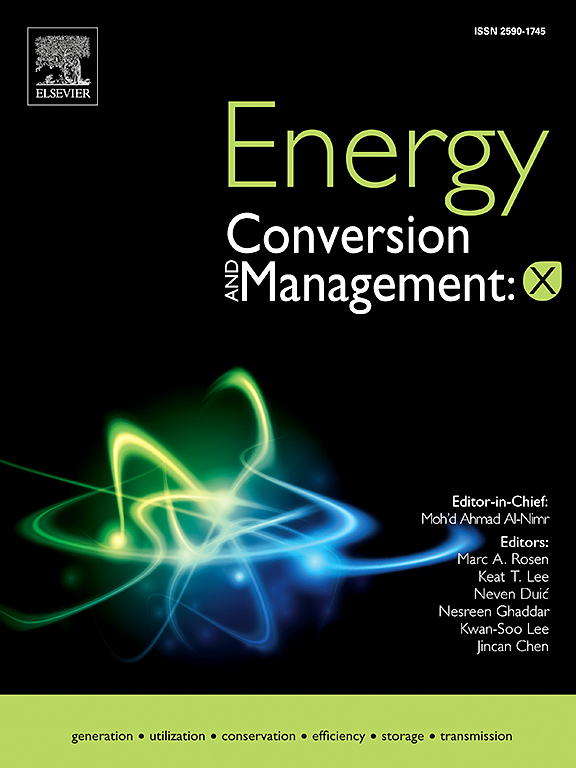Comparative techno-economic analysis of integrated solar PV and methane–methanol production systems for enhanced waste management solutions
IF 9.9
1区 工程技术
Q1 ENERGY & FUELS
引用次数: 0
Abstract
As the global demand for sustainable energy solutions grows, the integration of renewable technologies into waste management systems has gained significant attention. This study investigates the integration of power-to-gas (P2G) and power-to-liquid (P2L) technologies within waste management units through a comprehensive techno-economic analysis. Multi-objective optimization was conducted to determine the optimal number of solar photovoltaic (PV) panels, aiming to maximize the Cumulative Fuel Production Potential (CFPP) while minimizing the Total Annual Cost (TAC). Five distinct scenarios were proposed, validated, and compared from technical, economic, and environmental perspectives. The five scenarios involve combinations of anaerobic digestion, gasification, mechanical biological treatment, power-to-gas, and power-to-liquid technologies for sustainable waste management and fuel production. The first scenario focuses on methane production, the second focuses on methanol production, and the other three focus on co-production of methane and methanol. The optimization revealed that scenarios 2 to 5 required approximately 8,500 to 8,900 solar PV panels, while scenario 1 necessitated only half that amount, indicating a consistent hydrogen demand across scenarios. Technically, scenario 3 exhibited the highest CFPP at 9.25 MJ/kgMSW, showcasing significant fuel production potential. Economically, scenario 1 demonstrated the lowest TAC, while scenario 5 had the highest, suggesting that anaerobic digestion is more cost-effective than gasification. Environmentally, scenario 1 and scenario 5 also showed the lowest Global Warming Potential (GWP), highlighting the advantages of combining power-to-liquid and power-to-gas technologies in reducing carbon footprints. Overall, scenario 3 emerged as the most favorable option due to its optimal balance of high CFPP and moderate TAC.
综合太阳能光伏和甲烷-甲醇生产系统的技术经济比较分析,以增强废物管理解决方案
随着全球对可持续能源解决方案需求的增长,将可再生技术纳入废物管理系统得到了极大的关注。本研究通过全面的技术经济分析,调查了废物管理单位中电力制气(P2G)和电力制液(P2L)技术的整合。以最大累积燃料生产潜力(CFPP)和最小总年成本(TAC)为目标,进行多目标优化,确定太阳能光伏(PV)板的最优数量。从技术、经济和环境的角度提出、验证并比较了五种不同的方案。这五种方案涉及厌氧消化、气化、机械生物处理、电力制气和电力制液技术的组合,以实现可持续的废物管理和燃料生产。第一种方案侧重于甲烷生产,第二种方案侧重于甲醇生产,其他三种方案侧重于甲烷和甲醇的联合生产。优化结果显示,方案2到方案5需要大约8500到8900块太阳能光伏板,而方案1只需要一半的数量,这表明不同方案的氢需求是一致的。从技术上讲,方案3的CFPP最高,为9.25 MJ/kgMSW,显示出巨大的燃料生产潜力。经济上,情景1的TAC最低,而情景5的TAC最高,这表明厌氧消化比气化更具成本效益。在环境方面,情景1和情景5也显示出最低的全球变暖潜能值(GWP),突出了将电力制液和电力制气技术相结合在减少碳足迹方面的优势。总体而言,方案3由于其高CFPP和中等TAC的最佳平衡而成为最有利的选择。
本文章由计算机程序翻译,如有差异,请以英文原文为准。
求助全文
约1分钟内获得全文
求助全文
来源期刊

Energy Conversion and Management
工程技术-力学
CiteScore
19.00
自引率
11.50%
发文量
1304
审稿时长
17 days
期刊介绍:
The journal Energy Conversion and Management provides a forum for publishing original contributions and comprehensive technical review articles of interdisciplinary and original research on all important energy topics.
The topics considered include energy generation, utilization, conversion, storage, transmission, conservation, management and sustainability. These topics typically involve various types of energy such as mechanical, thermal, nuclear, chemical, electromagnetic, magnetic and electric. These energy types cover all known energy resources, including renewable resources (e.g., solar, bio, hydro, wind, geothermal and ocean energy), fossil fuels and nuclear resources.
 求助内容:
求助内容: 应助结果提醒方式:
应助结果提醒方式:


